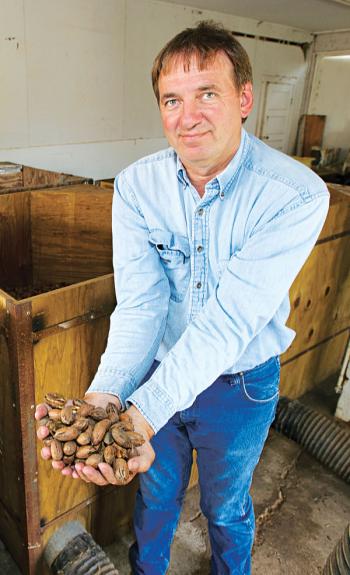
LSU AgCenter pecan specialist Charlie Graham displays a handful of pecans on Nov. 3 at the AgCenter Pecan Research and Extension Station in Shreveport. After harvest, pecans are dumped into wooden containers, which are then moved into this room to be dried. Air is blown into the bottoms of the containers through the black hoses seen in this photo. Photo by Olivia McClure/LSU AgCenter
2016 pecan crop struggling in Louisiana, nationwide
Louisiana pecan growers who were eager to bounce back from a less-than-stellar crop last year will likely have their hopes dashed this year, with smaller-than-usual harvests predicted for the state and nationwide.
Insects, mites and disease have caused trees in Louisiana to defoliate and yields to drop. But fortunately, prices and demand remain strong, said LSU AgCenter pecan specialist Charlie Graham.
Louisiana growers will likely harvest 4 million to 5 million pounds of pecans this year, Graham said. Between 260 million and 270 million pounds are forecast for the national total, which he said is low for an “on year.”
Pecan trees alternate between “on years” with heavy production and “off years” with lighter production.
Harvest in Louisiana typically begins in October, and most growers want to finish by Thanksgiving. But wet weather can prolong harvest into January.
Although pecan trees in the Cloutierville and Tallulah-Waterproof areas are doing well, they are outliers in a state that has been coping with significant pest pressure recently, Graham said.
Scorch mites, an insect that causes trees to defoliate, were a major problem in late summer 2015.
“The sparse foliage in the fall resulted in the trees storing limited reserves for the dormant season, and that’s going to affect your production the following year,” Graham said.
Some of the foliage loss is also attributed to a fungal disease called neofusicoccum, which has gradually been taking hold on pecan trees since 2012, he said.
The disease has been particularly rough on Elliot pecan trees. Growers of that variety often don’t spray fungicides because the trees have good resistance to scab, a common disease in pecans, Graham said. But Elliot trees are very susceptible to neofusicoccum.
“I’ve seen Elliot trees 60, 70, 80 percent or more defoliated because of neofusicoccum,” he said.
Growers in Pointe Coupee Parish, the top pecan-producing parish, have reported having their second year in a row with “very poor” production, something they’ve never experienced before.
“There’s a lot of growers in those areas with high hopes for next year, and we expect that to be a good crop,” Graham said.
Heavy rains in August saturated the soil enough to allow shuck splitting to proceed normally despite recent dry conditions, Graham said. Drought sometimes delays shuck split, leading to increased vivipary, or premature germination, of nuts.
Nationally, growers will harvest fewer pecans this year, partly because Hurricane Hermine in September caused extensive damage to trees in Georgia, the No. 1 pecan-producing state.
International demand has continued to grow. Pecans are a novelty item in many countries, Graham said, and are especially popular in China, where customers like to buy them for the Chinese New Year.
Some countries are considering lowering tariffs that are as high as 20 to 30 percent of the price of imported pecans, which may encourage further expansion of the international market, Graham said.
The U.S. pecan industry has increased international promotions following an increase in Market Access Program, or MAP, funding from the U.S. Department of Agriculture’s Foreign Agriculture Service. The industry expects at least $800,000 in funding for the 2017 pecan season, Graham said.
The industry also recently passed a federal marketing order for pecans, he said. Overseen by the USDA, the program established the first-ever American pecan marketing board, which will collect a to-be-determined fee per pound from growers to be spent on research and domestic promotions.
Graham estimates Louisiana has between 19,000 and 21,000 acres of native pecans, but there has never been a requirement to report pecan acreage.
Some pecans are grown commercially, but many more come from trees in people’s yards and in native groves in river bottoms. Most are sold to shelling facilities in other states because there are only a few in Louisiana.
Louisiana’s national ranking for pecan production varies from year to year but generally falls between fifth and seventh place, Graham said. Georgia, Texas and New Mexico hold the top three places, respectively.
In 2015, Louisiana pecans had a gross farm value of about $6.5 million, according to the AgCenter Ag Summary.
- Log in to post comments

